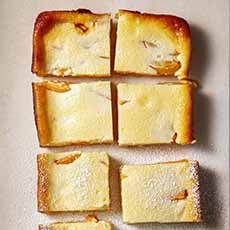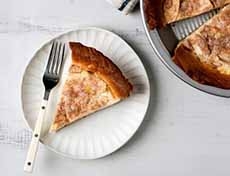
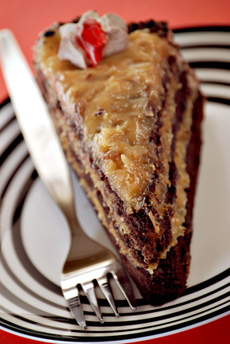 German chocolate cake—named after Sam German, not the country Germany—is a chocolate layer cake with a rich coconut and pecan filling and topping. Photo © HD Connelly | Fotolia. German chocolate cake—named after Sam German, not the country Germany—is a chocolate layer cake with a rich coconut and pecan filling and topping. Photo © HD Connelly | Fotolia.
June 2008
Last Updated December 2025
|
|
All Kinds Of Cake: A Great Cake Glossary
Page 4: Terms G To K
There are thousands of different types of cakes in the world today; each culture has its specialties, most of which never reach our shores. Here, we present some of the more popular types one is likely to encounter—or at least hear about—in the U.S. If your favorite isn’t represented, tell us about it. After you’ve checked out the cakes, take a look at our other food glossaries—an easy way to get up to speed on more than fifty different food categories. Most related to this Cake Glossary are our Chocolate Glossary, Custard Glossary, Dessert Sauce Glossary, Ice Cream & Frozen Desserts Glossary, and Sugar Glossary.
Click on a letter to go to the appropriate glossary section.
a b c d e f g h i j k l m n o p q r s t u v w x y z
This glossary is protected by copyright and cannot be reproduced in whole or in part. You are welcome to link to it.
GANACHE
The definition of ganache is both short—a mixture of chocolate and cream—and lengthy. In the cake world, ganache refers to a very rich, thick, velvety icing made with melted chocolate and heavy cream. It is semi-firm and has a nice sheen. When it is beaten with butter as a filling and frosting for cakes and pastries, it is known as ganache beurre or ganache soufflé. In its heated, liquid state, it can be poured over cakes and pastries as a glaze. Average chocolate makes average ganache; great chocolate makes great ganache. Also, see the definition for ganache in the chocolate glossary.
GALETTE
A galette is a rustic, open-faced pie, although some classify it as a tart or cake. It is flat, with a flaky, turned-up crust that creates a bowl around the fruit inside (the photo at right shows a peach galette). It is made without a pie pan. In Italian, it is known as a crostata.
GALETTE DES ROIS
See Epiphany Cake.
GÂTEAU
Gâteau is the French word for cake. It is generally a more delicate and complex confection than an American layer cake, with a gènoise base and a cream or buttercream filling. It can be light or rich, rectangular or round, and often has fresh decorations such as fruit or whipped cream that make it perishable. Gâteau can also be very elaborately decorated with spun sugar and chocolate.
|
|
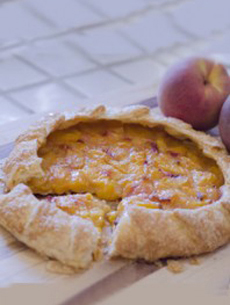
A peach galette from Frog Hollow Farm, a NIBBLE Top Pick Of The Week. |
GATEAU SAINT-HONORÉ, GATEAU ST.-HONORÉ or SAINT HONORÉ CAKE
This French classic has a base of puff pastry and a circle of pâte à choux (cream puffs), dipped in caramelized sugar, around the rim. The base is traditionally filled with crème chiboust (a lighter crème pâtissière) and topped with crème chantilly (whipped cream, often using a special St.-Honoré piping tip, which is notched with a deep “V” to create a classic peaked ridge style of piping (see photo). Some pastry chefs add a dome of spun sugar.
|
|
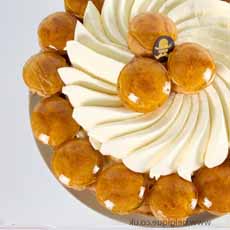
A classic gâteau Saint-Honoré: Centres Sociocultures - Bar Le Duc. |
The cake is attributed to Chiboust, a Parisian pastry chef, who named it in 1846 after the Saint-Honoré district where his patisserie was located. Saint-Honoré or Honoratus (d. 600 C.E.) was the bishop of Amiens in northern France and is the patron saint of bakers and pastry chefs.
In 1202, a baker named Renold Theriens or Renaud Cherins donated land to the city of Paris to build a chapel in honor of the saint. The chapel became one of the richest in Paris and gave its name to Rue du Faubourg Saint-Honoré. In 1400, the bakers of Paris established their guild in the church of Saint Honoratus, celebrating his feast on May 16.
GÉNOISE
Génoise is a type of sponge cake made with butter, which is so-called because it was invented in the Italian city of Genoa. It is used to make round cakes, square cakes, and jelly rolls.
A light mixture of whipped eggs and sugar, with flour and butter. Folded, it bakes into a firm texture that allows it to be cut into thin layers that are the base for most French gâteaux. Citrus juice and zest, cocoa powder, nuts, and other flavors can be added to the batter; the baked sponge can be layered with any number of flavored buttercreams, whipped creams, liqueur- or other flavored syrups (coffee, rose, orange water), sprinkled with toasted nuts, praline, and fruit, topped with sugar icing, whipped cream or ganache—not to mention elaborately decorated with buttercream flowers, glazed fruit, marzipan, spun sugar and buttercream. The possibilities are truly endless.
Top photo: Génoise is baked or cut into thin layers (photo at left), rectangular or round, which are then layered with filling—buttercream, mousse, whipped cream, etc.—and frosted to create a beautiful cake. Photo courtesy FinancierPastry.com. Bottom photo: Génoise, or sponge cake, before it is cut into layers for frosting and decorating. Photo courtesy Femmeactuelle.fr.
|
|
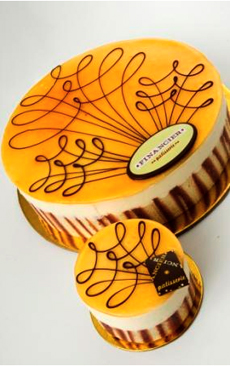
Génoise is baked or cut into thin layers, rectangular or round, which are then filled with buttercream, mousse, whipped cream, etc.—and frosted to create a beautiful cake (photo © Financier Pastry). Below, the plain sponge.
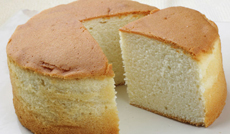
|
GERMAN CHOCOLATE CAKE
A chocolate layer cake with a rich coconut pecan filling and a chocolate frosting, topped with more coconut.
German chocolate cake does not come from Germany or from German immigrants. German chocolate is a milder, sweeter baking chocolate (milk chocolate would not be invented until 1876, by Daniel Peter in Vevey, Switzerland). According to Kraft Foods, which now owns Walter Baker & Company, German chocolate cake was created in 1852 by Sam German, an Englishman who worked in the U.S. for Walter Baker & Company. Originally called Baker’s German’s Sweet Chocolate, the apostrophe-s was later dropped, adding to the confusion.
|
|
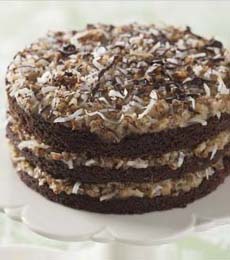
This German Chocolate Cake can be ordered from MackenzieLtd.com. |
The popular recipe for German Chocolate Cake was submitted to a Dallas newspaper almost 100 years later, in 1957, by a Texas housewife who may or may not have invented it. In light of the resulting demand for German chocolate, General Foods (since merged with Kraft) sent the recipe to newspapers nationwide, and the cake became a national hit. Numerous recipes can be found that are called “German Chocolate Cake” but contain none of the differentiating ingredients (German chocolate, coconut, pecans).
GROOM’S CAKE
A southern tradition, a separate wedding cake was baked called the “groom’s cake,” to be sliced and boxed for the unmarried women attending the wedding. The cake would be taken home and placed under her pillow, with hopes of dreaming of her future husband. (The “cake under the pillow” to engender dreams is a continuation of an old European tradition, but there was no separate groom’s cake.) Today, the groom’s cake reflects his tastes in cake and a design that reflects his interests (chessboards, cowboy boots, sports themes). It tends to be a much smaller cake than the wedding cake, often just two large layers, and often chocolate.
|
|
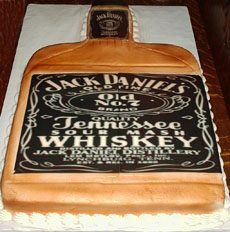
You’ve got to love this groom’s cake, made by CelebrationCakes.com. |
HERRENTORTE OR GENTLEMEN’S CAKE
A sophisticated cake from 19th-century Germany, the original Herrentorte typically consists of several (often six) thin layers of Viennese sponge cake, which are filled with a rich pastry cream made with fine spirits such as Cognac or rum plus wine. Some versions include a layer of apricot jam.
The top layer of marzipan is covered with dark chocolate ganache. It’s not the simplest cake to make, but worth it! Here’s a recipe.
It’s called “gentlemen’s cake because it is covered in dark ganache." Historically, in Germany, dark chocolate was called “gentlemen’s chocolate” (Herrenschokolade) because its bitterness was supposedly less appealing to women.
|
|
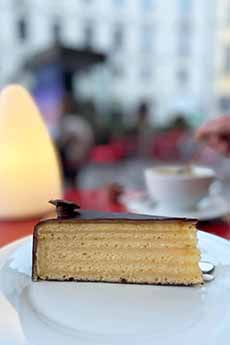
Herrentorte is a classic of the German Kaffehaus and was for a long time the traditional German birthday cake (photo © Cinnamon and Coriander). |
HUGUENOT TORTE
An apple-pecan torte that’s a famous dessert of Charleston, South Carolina. The recipe was adapted from an apple pudding from the Mississippi Delta Ozarks and served at Charleston’s Low Country-cuisine Huguenot Tavern in the 1940s. The cake is traditionally served with whipped cream and garnished with apple slices, pecan halves, and fresh mint.
|
|
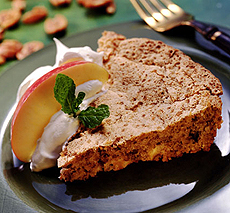
Huguenot torte. Photo © American Egg Board, which has a recipe.
|
HUMMINGBIRD CAKE
Another southern classic, Hummingbird Cake, originated in Jamaica. The recipe was printed on a brochure from the Jamaica Tourist Board. It was submitted by a reader to Southern Living magazine and first published in the February 1978 issue. There was no explanation of the name*, but FoodTimeLine.org cites a 1985 article in the Arkansas Gazette that says the cake also was called Cake That Doesn’t Last, Cake That Won’t Last, Granny’s Best Cake, and Never Ending Cake. The batter includes bananas, crushed pineapple, and pecans or walnuts, and the cake is filled and frosted with cream cheese frosting and typically topped with more chopped nuts. Thinks banana nut cake with pineapple and cinnamon. Here’s more about Hummingbird Cake’s history and recipes.
______________
|
|
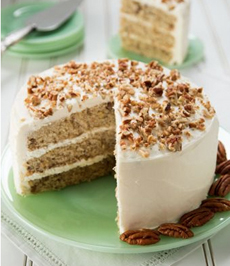
Hummingbird Cake is made with light brown muscovado sugar and topped with pecans. You can buy this cake from Vermont Country Store. |
*Hummingbirds are among the smallest of birds, most species measuring in the 3–5 inch range. The smallest extant bird species is the bee hummingbird, weighing less than a penny.
ICE BOX CAKE, ICEBOX CAKE, or REFRIGERATOR CAKE
An ice box cake requires no baking. It’s composed of cookies or lady fingers and whipped cream or pudding (some recipes use Jell-O) and is set in the refrigerator. Chocolate and lemon are popular flavors. These cakes evolved in the early 1900s and became popular in the 1920s when Nabisco published a recipe for its Famous Chocolate Refrigerator Roll on the box. As you can see in the photo, whipped cream and chocolate wafers are stacked into what is called a zebra cake. The whipped cream softens the cookies and makes the “cake” easy to slice. Here’s a recipe for Chocolate Ice Box Cake, other icebox recipes, and the history of icebox/icebox cake.
|
|
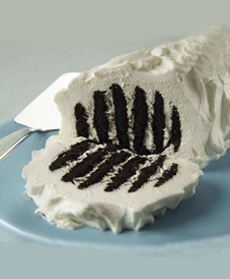
Nabisco’s Famous Chocolate Refrigerator Roll. Get the recipe. |
ICING
See frosting.
ITALIAN CREAM CAKE
An Italian cream cake is a moist white layer cake with cream cheese frosting, topped with coconut and pecans.
ITALIAN MERINGUE
Italian meringue is a stable, soft meringue that is made with sugar syrup instead of granulated sugar. It is used to frost cakes and pastries and added to buttercream to make mousseline, a lighter frosting.
|
|
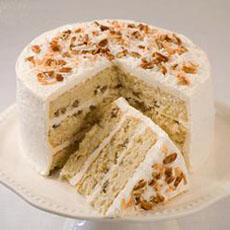
This mouth-watering Italian cream cake is available from LittonsDirectToYou.com. Photo © Litton’s Direct To You. |
JAM
Jam is a popular cake filling. Almost any flavor can be used; common flavors include apricot, blackberry, black and red cherry, black currant, orange, peach, pineapple, raspberry, and strawberry.
JELLY ROLL, ROULADE, or SWISS ROLL
A sponge role filled with jelly. Jelly-filled layer cake is an old English recipe. The earliest known reference to a rolled cake spread with jelly was published in Utica, New York, in December 1852. Called Jelly Cake, the hot cake was spread with jelly, rolled, wrapped in a cloth, and cut into slices when cool. Here’s a recipe.
In the U.S., the name evolved to Roll Jelly Cake, Swiss Roll, Jelly Roll, and Rolled Jelly Cake. The names Swiss Roll and roulade are more appropriate when the cake is filled with frosting instead of jelly.
In French, all rolled cakes are called roulade, from the verb rouler, meaning to roll. Savory roulades are made with meats, particularly chicken and veal.
|
|
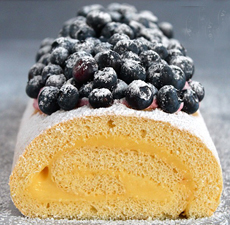
A lemon sponge rolled with lemon curd. A pumpkin sponge rolled with whipped cream (photo courtesy Vermont Creamery).
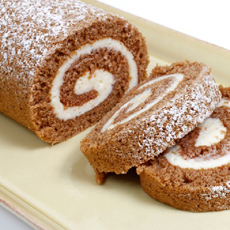
A pumpkin sponge rolled with whipped cream (photo courtesy Vermont Creamery).
|
KARPATKA CAKE
Karpatka is a traditional Polish dessert that’s essentially a giant cream puff. Choux dough—the same dough used for cream puffs and éclairs— is baked in two cake pans, creating the crispy top and bottom layers of the cake. It’s then filled with a rich vanilla pastry cream.
The top layer of choux pastry puffs up irregularly during baking and often cracks, creating what can be poetically interpreted as the rugged, craggy peaks that resemble the Carpathian Mountains (Karpatka in Polish), which form the southern border of the country†. A dusting of confectioners’ sugar is added to resemble snow.
The recipe is relatively modern. Though its exact origins are unclear, it emerged during the communist era in Poland (roughly the 1970s-1980s).
In addition to being delicious and attractive, it became popular partly because it could be made with relatively simple, available ingredients during a time when many foods were rationed or hard to obtain.
|
|

Karpatka Cake, so named because the layers resemble the peaks and valleys of the Carpathian mountains (all photos © Taste Of Home).

Bet you can’t have just one slice!
|
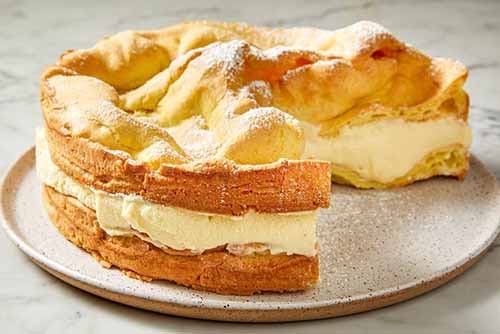
_______
†Slovakia is the primary country directly south across the Carpathians from Poland, but the mountain range is quite extensive, roughly 1,500 kilometers, and it also touches on Ukraine to the southeast of Poland. The mountain range also passes through or touches the Czech Republic, Hungary, Romania, and Serbia.
KING CAKE
The king cake is a Mardi Gras tradition in New Orleans, made only during this time of year (February). Fans all over the country purchase the cakes by mail order. It is typically a Danish yeast ring (some are elaborately braided), brioche, or cinnamon bread.
Most are covered in bright sanding sugars or icings in the Mardi Gras colors: green (faith), gold (power), and purple (justice). Some are filled with candied or glazed fruits; some wear gold paper crowns after the French Epiphany Cake, which is baked for the Feast Of The Epiphany (also called Three Kings’ Day), which is held the first Sunday after January 1.
The Epiphany Cake was brought to New Orleans in the late 1870s by French settlers, and the concept evolved into a Mardi Gras cake. However, Epiphany Cake (Galette Des Rois, Cake Of The Kings) is very different from King Cake.
It’s a low puff pastry layer filled with frangipane (almond cream), with an optional gold crown as the only decoration (top pâtissières may use spun sugar instead).
King Cake bakers adapted the Epiphany Cake tradition of baking a coin or charm into the cake. The person who gets the slice with it becomes “king for a day” and gets to wear the crown. He/she also earns the honor of buying next year’s cake. In New Orleans, a small plastic baby “charm” representing the Baby Jesus is traditionally inserted into the cake. However, more than a few bakers omit it due to the possibility that someone might swallow it or choke. And when it is included, the token is pushed into the underside of the baked cake (no plastic item can be baked in the cake due to melting).
|
|
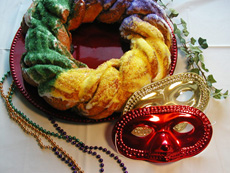
The Mardi Gras King Cake is a yeast ring decorated in the holiday’s colors (photo 1-800-Bakery).
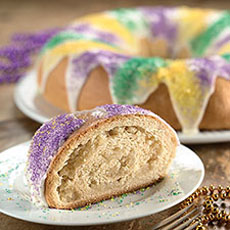
A variation of Mardi Gras cake, a yeast cake rolled with nuts.

Galette de Rois for the Feast Of The Epiphany (photo BainFrance.blogspot).
|
KUGELHOPF or KOUGELHOPF
The kugelhopf, a Viennese specialty, is a sweet yeast bread similar to brioche and panettone. The traditional version usually contains yeast, raisins or currants, and is topped by a snowy layer of powdered sugar. It was a favorite of the Austrian princess Marie Antoinette. Over the years, denser cakes were baked in the same fluted molds. The original molds were earthenware; later molds were made of glass or metal. The name kugelhopf derives from the German word Kugel, meaning round or ball (“Kugelkopf,” with a “k,” means “spherical head”), although the actual kugelhopf somewhat resembles a pleated hat like a turban or toque.
|
|
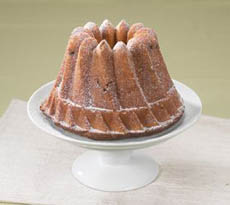
The Kugelhopf is the ancestor of the more famous Bundt cake. Photo courtesy Nordicware.com. |
Kugelhopf is also popular in the Alsace region of France, where it is made with raisins and lemon peel and has a glaze topped with sliced almonds. See the history of the Bundt pan.
Go To The Next Page: Terms With L & M
Go To Article Index Above

|

























